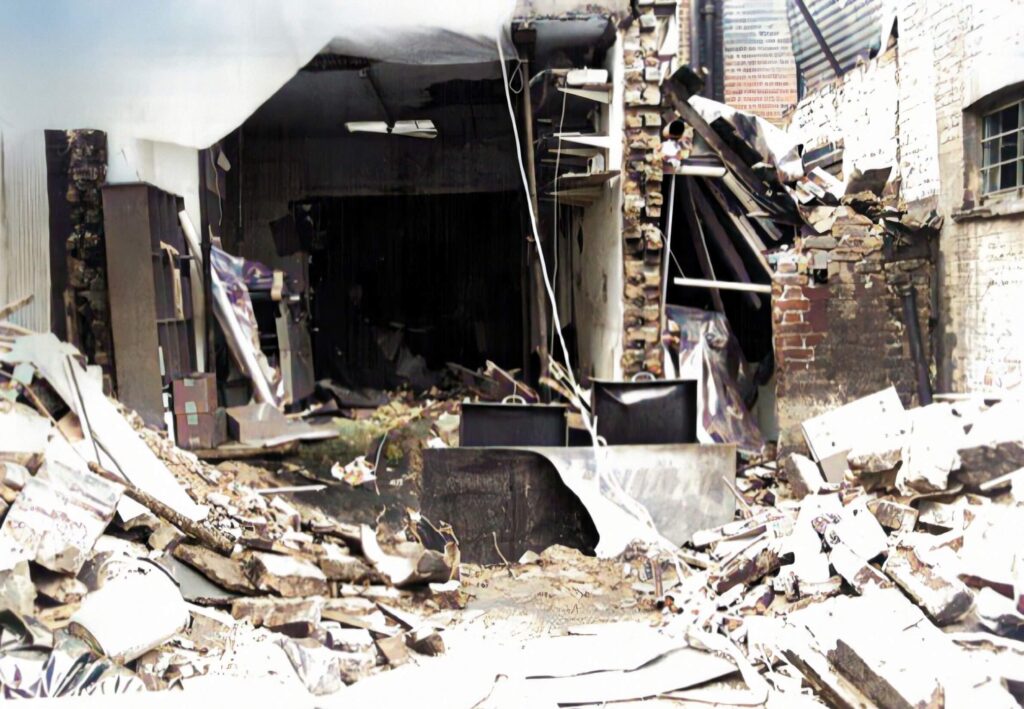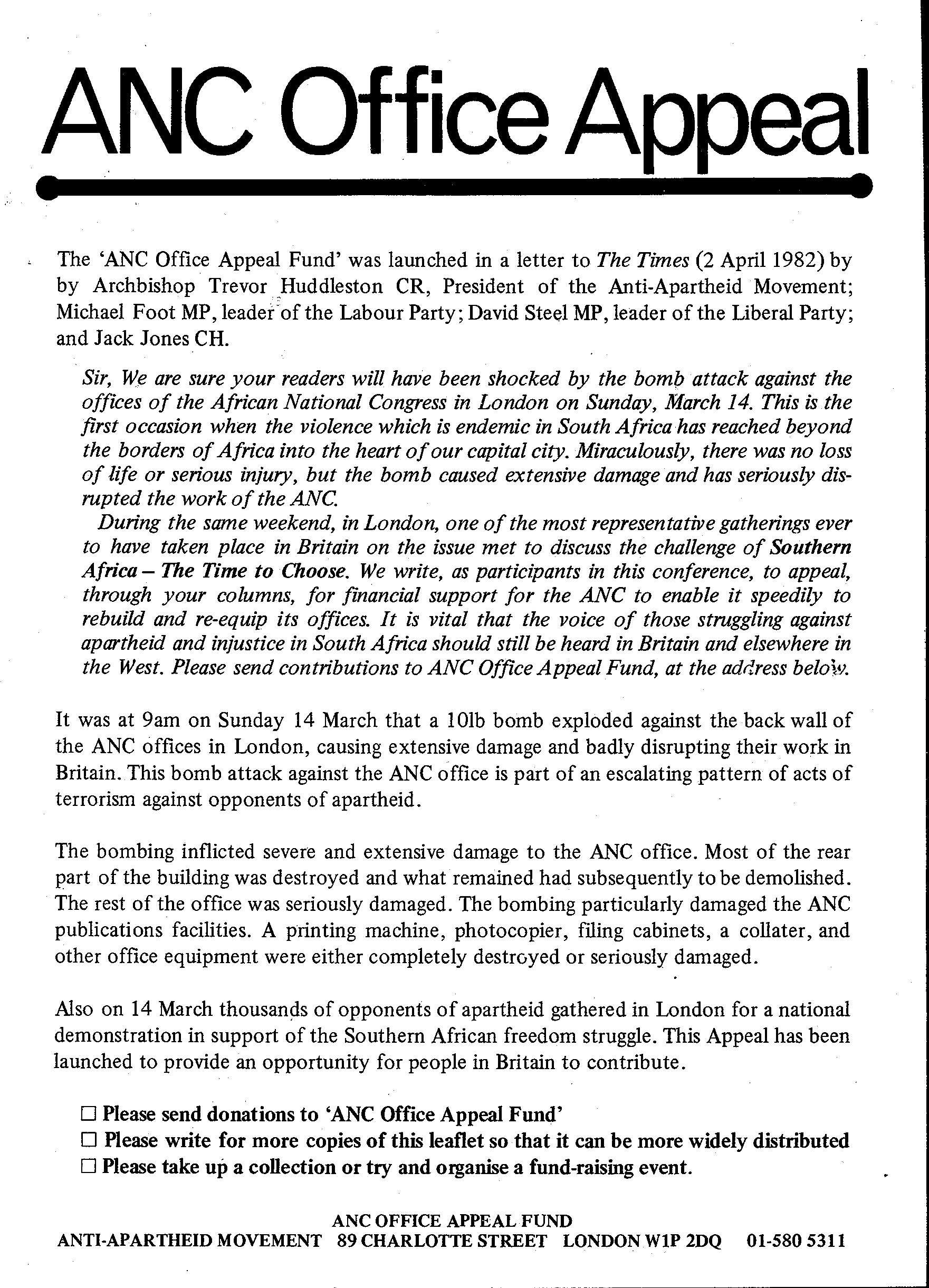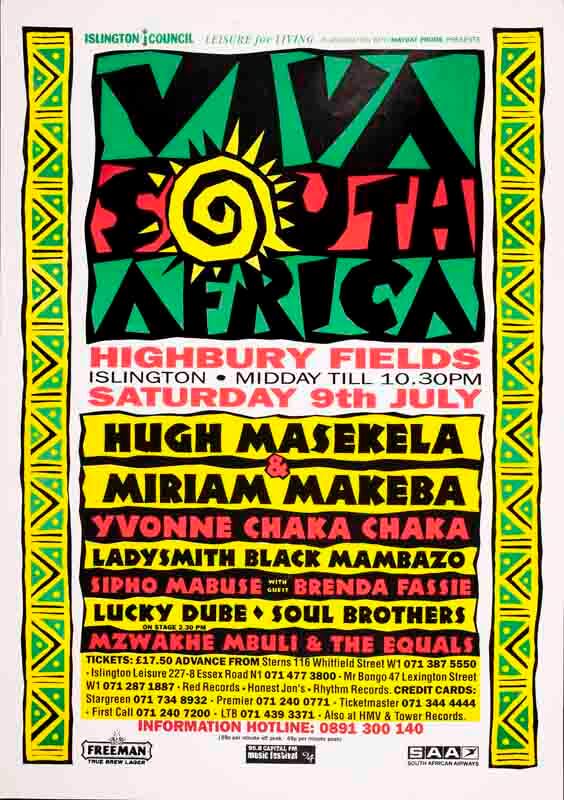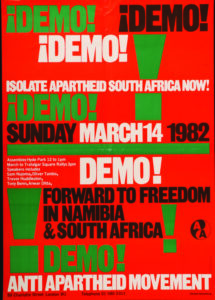 At 9am on 14th March 1982, an 11lb bomb exploded at the rear wall of 28 Penton Street, the UK headquarters of the then exiled African National Congress.
At 9am on 14th March 1982, an 11lb bomb exploded at the rear wall of 28 Penton Street, the UK headquarters of the then exiled African National Congress.
It is likely that ANC President Oliver Tambo was expected to be in the building for he had been due to address large crowds of anti-apartheid demonstrators in Trafalgar Square later that day, on the poster (shown, right of page).
ANC researcher and volunteer, Mr. Vernet Mbatha, was the only person on site at the time. He sustained minor physical injuries and managed to escape by climbing onto the roof and across neighbouring buildings
The staircase had been demolished in the blast. The ANC’s publication facilities were damaged, along with important records and office equipment which were also destroyed.
Above left image shows damaged neighbouring buildings, in the background of the left hand picture stands the former White Lion Free School, today this building is Lift Youth Hub. In the foreground, a building to the rear of 28 Penton Street with a destroyed roof.
Above right image shows the impact of the blast on 28 Penton Street itself, with back of the building blown off and furnishings, including printing press and other items damaged or destroyed.

Mr Vernet Mbatha (centre) after the explosion. image: Ramesh Sharma and Martin Argles/the Guardian
“South African agents had blown up our small ANC printing press located in the Penton Street ANC office in London. Remarkably the actual printing machine, although thrown through a wall, was repairable and was soon set to work again at new premises. A year later a new printing press was established at secret premises…churning out millions of sheets of both our underground printed material and material for our increasing international campaign. Instead of destroying the press, the regime had spurred us on by the bombing, to develop what was by far the most valuable and vital resistance tool in the ANC arsenal at the time” Patric Tariq Mellet (Activist and ANC printer)
LOCAL IMPACT and POLITICAL AFTERMATH
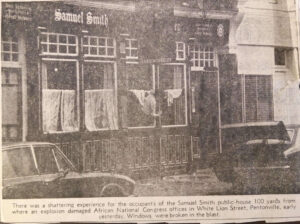 The impact of the apartheid regime’s divisive and often violent policies were directly experienced by the local community and supporters of the anti-apartheid solidarity movements. The bombing happened not too far from Chapel Market, posing serious danger to stallholders, who were setting up at the time, and early shoppers.
The impact of the apartheid regime’s divisive and often violent policies were directly experienced by the local community and supporters of the anti-apartheid solidarity movements. The bombing happened not too far from Chapel Market, posing serious danger to stallholders, who were setting up at the time, and early shoppers.
Windows of neighbouring buildings were shattered, including the Samuel Smith pub (pictured below) and the White Lion Free School, both on White Lion Street and situated metres away from the explosion.
Debris from the blast was found nearly 400m away, windows of buildings up to 500m away and the explosion was heard as far away as Stoke Newington. The Islington Gazette, in an article published on 19th March 1982, commented that the attack “revived wartime memories of the Blitz.”
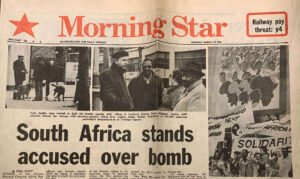 The Anti-Apartheid Movement (AAM) and other liberation solidarity movements pointed the finger at Pretoria for the bomb. Many believed strongly that the Bureau of State Security (BOSS), Pretoria’s intelligence and covert operations service agency, was behind the brazen attack. Calls were made for special government security arrangements to be put into place for the leadership of the liberation movements in the UK but Scotland Yard reportedly saw no reason for this measure.
The Anti-Apartheid Movement (AAM) and other liberation solidarity movements pointed the finger at Pretoria for the bomb. Many believed strongly that the Bureau of State Security (BOSS), Pretoria’s intelligence and covert operations service agency, was behind the brazen attack. Calls were made for special government security arrangements to be put into place for the leadership of the liberation movements in the UK but Scotland Yard reportedly saw no reason for this measure.
ADMISSION OF GUILT
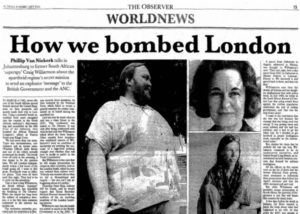 Nine former agents of the apartheid security apparatus admitted to the planning and execution of the bombing at the Truth and Reconciliation Commission (TRC).
Nine former agents of the apartheid security apparatus admitted to the planning and execution of the bombing at the Truth and Reconciliation Commission (TRC).
They told the TRC that they had been led by BOSS operative Craig Williamson, and had arrived in the UK on false documentation with the help of individuals in the South African Embassy in Trafalgar Square.
The bomb was assembled on the embassy’s 5th floor with parts brought into the country specifically for the mission.
THE REBUILD AND BEYOND
The British Council of Churches offered the ANC temporary office space in its central London office while 28 Penton street was rebuilt. Archbishop Trevor Huddleston, AAM President and an anti-apartheid veteran who’d lived in South Africa and witnessed the the effects of apartheid, launched the ‘ANC Office Appeal Fund’ to aid reconstruction of the building. It was supported by Labour Party Leader, Michael Foot MP, Liberal Party Leader David Steel MP, and British trade union leader, Jack Jones CH (later MBE).
After the rebuild, the ANC returned to Penton Street and continued to coordinate many important campaigns including ‘Votes for Freedom’ in the lead up to the 1994 elections. In 1994, following over 45 years of apartheid in South Africa, the first democratic elections were held. The ANC’s Nelson Mandela was sworn in as President.
There were global celebrations after the 1994 elections. Fitting for the borough that had homed the ANC, Islington Council organised a tribute concert held on nearby Highbury Fields (see above image). Anti- aparthied stalwarts and musicians performed, included Hugh Masekela and Miriam Makeba who headlined.
The ANC no longer needed their Islington base. Action for Southern Africa (the AAM’s evolution) used the premises from 1994 until 2008. A green heritage plaque was installed on the building in 2010 to commemorate the ANC’s 16 years in Penton Street and the contributions of local residents to the struggle against apartheid.



